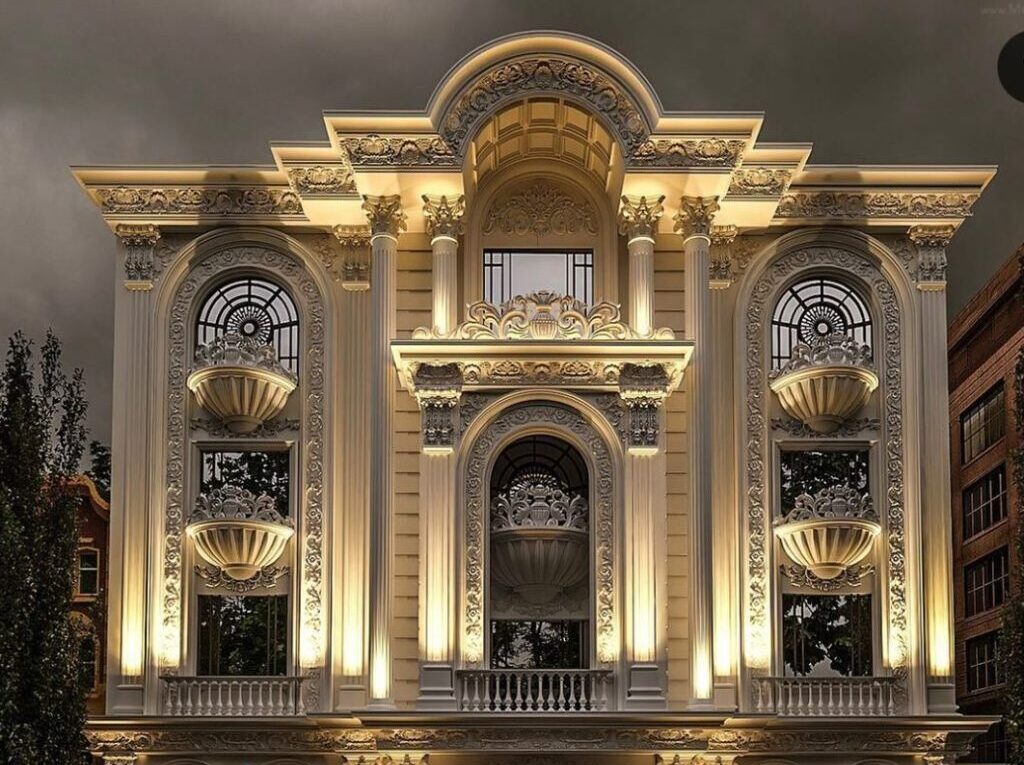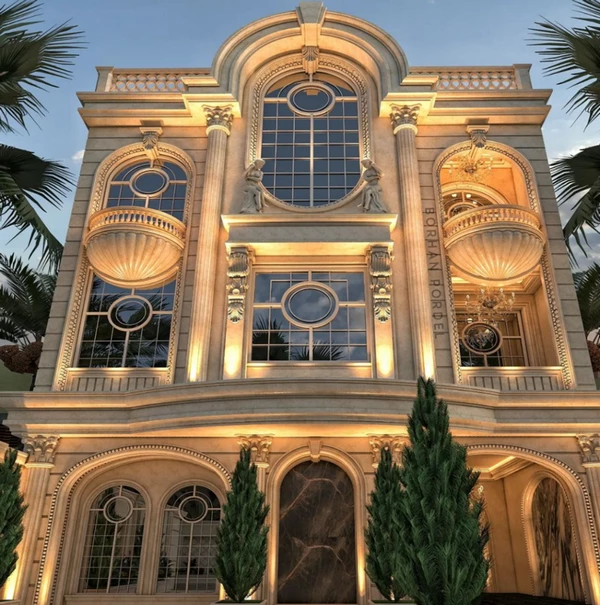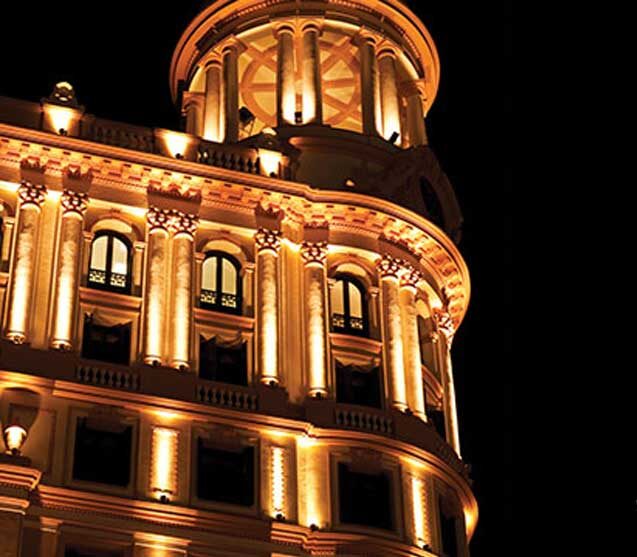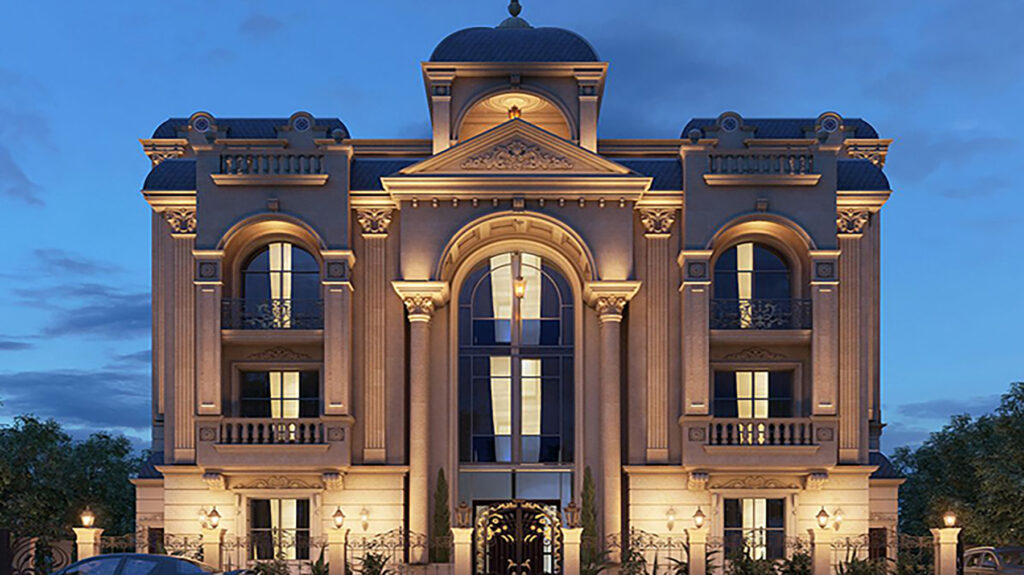Roman architecture and the lighting design of Roman building facades have become very popular in recent years and require special techniques for lighting. The capitals used in Roman facades have complex and beautiful details. The grandeur of this style is not revealed without Roman facade lighting at night. It is necessary to have a complete understanding of the Roman architectural style and lighting systems and equipment to carry out the lighting with greater precision while preserving the artistic elements of the structure. In lighting the Roman facade of a building, you must be careful that the intensity of the lighting does not disturb the residents of the residential building. By understanding elements such as arches and capitals, perform Roman facade lighting while preserving the authenticity of the structure.
What are the principles of Roman lighting?
Considering that the lighting of the building facade is visible from the outside and has a direct impact on the visual appeal of the building, great care must be taken in its lighting. Roman lighting has specific features that contribute to its grandeur and magnificence. These principles generally include the following:
- Symmetry and Balance: In Roman lighting, lights should be placed symmetrically on both sides of architectural elements, and all similar parts of the building should be lit equally.
- Emphasis on Architectural Details: Lights should be positioned in such a way that architectural details such as columns, arches, and statues are well-highlighted. Proper execution of these methods makes the architectural details prominent, impressing any viewer.
- Use of Warm Lights: Warm lights such as golden, yellow, and orange tones give the space a warm and pleasant feeling and help highlight the details in the facade lighting.
- Uplighting: This method is used to create a sense of height and grandeur. Lights are installed at the bottom of the building, and the light is directed upward.
- Combination of Ambient and Direct Lights: Using ambient lights to create uniform illumination and direct lights to emphasize specific points.
- Contrast of Light and Shadow: Creating contrast between illuminated and shadowed areas adds depth to the facade and increases its attractiveness.

Important Points in Using Roman Facade Lighting
- Determining the purpose of exterior facade lighting
- Maintaining balance in facade illumination
- Determining the angle of exterior facade lighting
- Identifying key points for facade lighting
- Choosing the appropriate light for building facade lighting
5 Models of Roman Lighting
Lighting with LED Strips
Using LED strips in Roman lighting can create beautiful and attractive effects. LED strips are a suitable choice for this type of lighting due to their low energy consumption, long lifespan, and color variety. Use LED strips hidden in the upper and lower parts of the windows. The clear pattern of the created light lines gives the building a beautiful visual appearance.
Lighting with LED Projectors
To create an attractive lighting design for Roman facades, do not overlook LED projectors. The stunning beauty and appeal of these projectors are unparalleled. They are also cost-effective and waterproof, resistant to rain, snow, and environmental factors, and can be used for many years. This powerful light source is easily installed on stone facades and has very low energy consumption.

Lighting with Delphi Recessed Lights
Roman lighting with Delphi recessed lights is one of the popular methods to create a beautiful and modern effect in the lighting of Roman buildings. Due to their specific design, Delphi recessed lights distribute light uniformly and directly, making them very suitable for emphasizing architectural details and creating impressive visual effects.
Lighting with Jet Lights
Using jet lights in Roman building lighting can help create a modern and impressive effect and enhance the beauty and grandeur of the building. Jet light is a type of pedestal spotlight that can be installed on the ground or any surface, projecting a linear and rapid light upwards onto the building. Choosing jet lights for Roman facade lighting is the best option for tall buildings and columns because of their light control, beam pattern, and performance. Additionally, jet lights are resistant to rain, snow, and environmental factors, and have a long lifespan.

Techniques of Roman Facade Lighting
Roman facade lighting can add to the grandeur and beauty of this architectural style. Here are some lighting techniques to create beautiful and attractive effects in Roman facades:
- Indirect Lighting
This technique involves installing lights behind architectural details such as columns, arches, and cornices. These lights indirectly illuminate the architectural surface, creating a soft and balanced effect.
- Accent Lighting
By using spotlights or small projectors, specific details of the Roman facade, such as columns, capitals, statues, and reliefs, can be highlighted.
- Ground Lighting
This technique involves installing lights on the ground and directing them upwards towards the building. These lights can give a majestic appearance to the Roman facade and beautifully illuminate the entire building facade.
- Color Lighting
Adding colored lights to the facade can help create attractive visual effects. Warm or cool colors can be used depending on the atmosphere and surroundings.
- Shadow Lighting
By positioning lights at specific angles, beautiful and prominent shadows can be created on the facade, adding depth and volume to the architecture.
- High-Efficiency LED Lighting
LED lights are an excellent choice for Roman facade lighting due to their high efficiency, low energy consumption, and long lifespan.
- Smart Lighting Control
Using smart control systems to adjust the timing and intensity of lighting can enhance visual effects and save energy.
These techniques can help create beautiful and prominent visual effects in Roman facades and showcase the grandeur and magnificence of this architectural style.

Final Words
Shamim Andisheh Company, with years of experience and professional specialists, has been responsible for the design and specialized execution of facade lighting projects and has used custom-made equipment produced by the company in some projects. You can confidently entrust the facade lighting of your building to Shamim Andisheh Company.

 English
English العربية
العربية

















